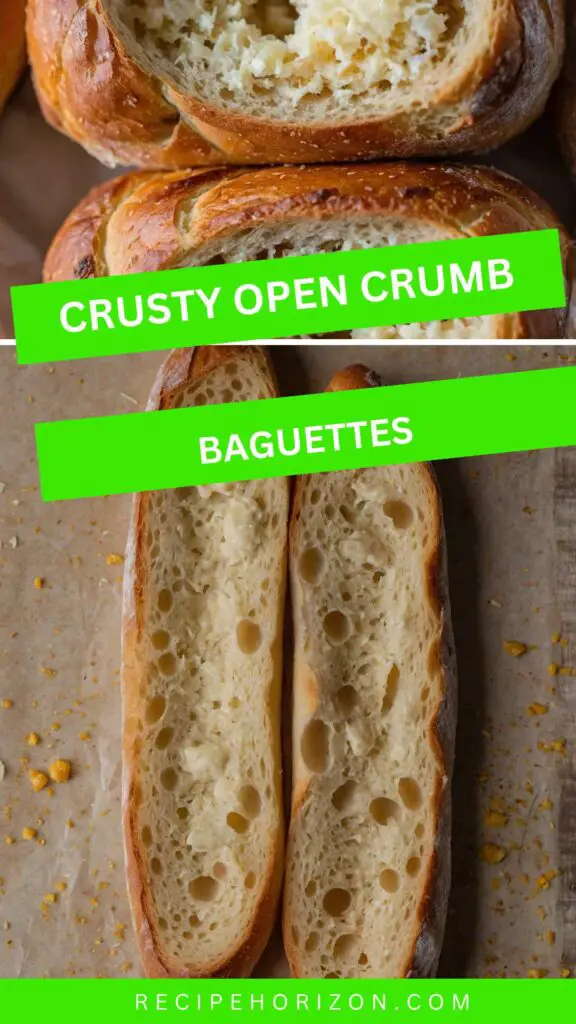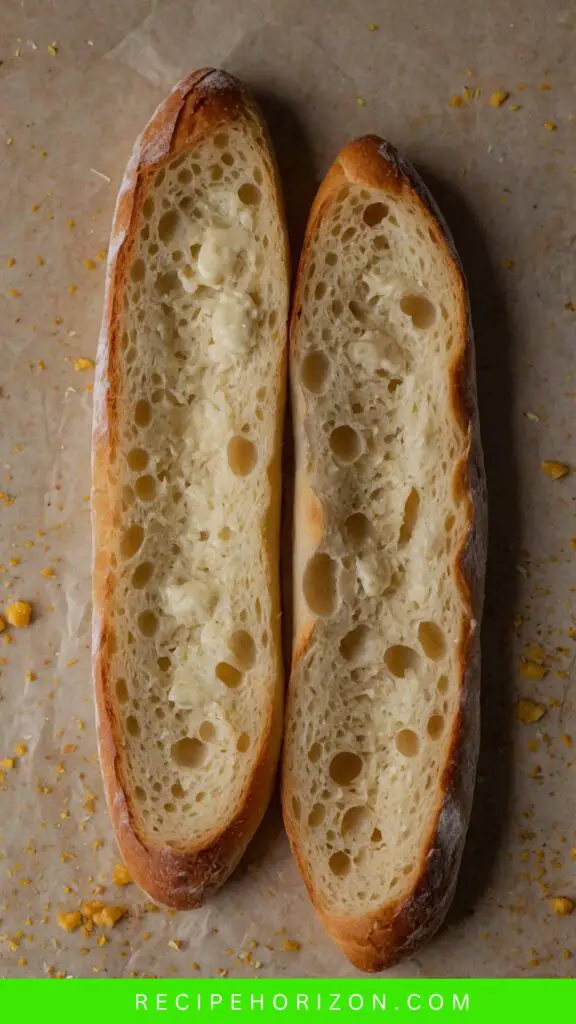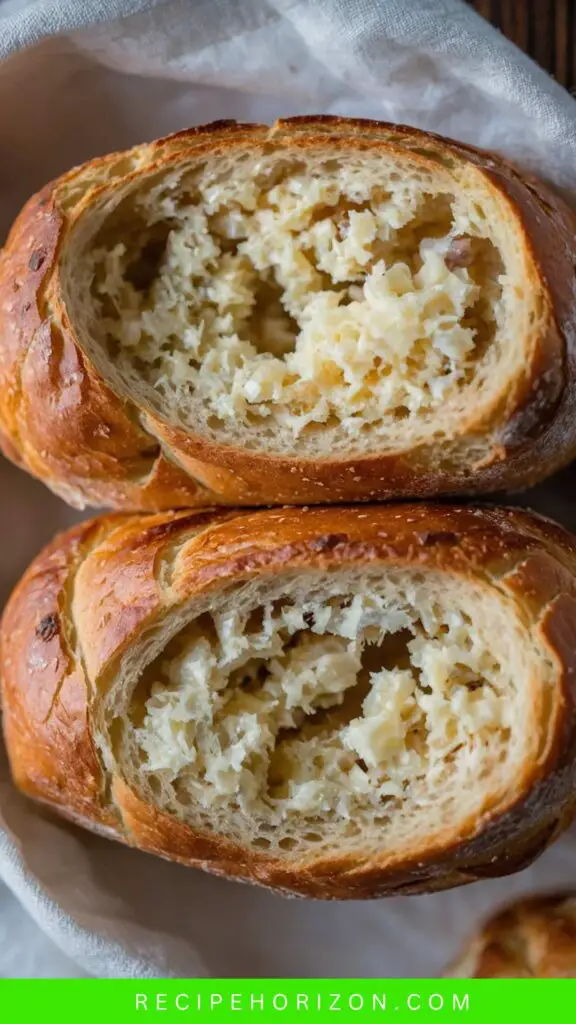There’s something truly magical about biting into a crusty open crumb baguette. Its crunchy exterior gives way to an airy, chewy interior, creating a comforting experience that is hard to beat. When I think of this fantastic bread, I can’t help but envision enjoying it fresh out of the oven with a dish that pairs perfectly: bruschetta.
The marriage of crispy bread topped with juicy tomatoes, basil, and a drizzle of balsamic vinegar feels heavenly.
What is Crusty Open Crumb Baguette?
Imagine a stunner on your dinner table that steals the show just by being there. The crusty open crumb baguette boasts a peculiar texture; the crust is firm, while the inside is airy and open with random holes.
This bread has a rustic charm, making it a staple in French kitchens and beyond. It’s versatile enough to serve alongside soups, stews, or even as a vehicle for your favorite spreads.

You Might Also Like These Recipes!
The Ingredients
Understanding the building blocks of our baguettes is crucial. Here’s what you’ll need for both the poolish starter and the final dough:
Poolish Starter
- 150 g unbleached all-purpose flour – This serves as the base of our bread.
- 0.15 g instant dry yeast – Just a pinch for fermentation.
- 150 g filtered water (room temperature) – Hydration is key for the dough’s development.
Final Dough
- 5 g honey – A hint of sweetness that enhances browning.
- 230 g lukewarm water – Helps the yeast activate perfectly.
- 350 g bread flour (or all-purpose if preferred) – The foundation of our dough.
- 10 g fine sea salt – Balances flavor and strengthens the dough.
- 8 g olive oil – Adds a touch of richness for a softer crumb.
- All of the prepared poolish – Our starter adds flavor and structure.
- 3 g instant yeast – Gives the dough a lift.
How to Make Crusty Open Crumb Baguettes?
We’ll break this process into manageable steps. Bologna’s got nothing on the beauty of freshly baked baguettes. Let’s roll our sleeves up and dive into the process.
Step 1: Prepare the Poolish
Start with the night before you want to bake. Combine the 150 g of unbleached flour, 0.15 g of instant yeast, and 150 g of filtered water in a bowl. Stir until it’s well mixed, then cover this bowl with plastic wrap. Let it rest at room temperature for 12-16 hours until it becomes bubbly and has risen.
Step 2: Mix the Final Dough
On baking day, grab your poolish starter and mix it into a large bowl. Add 230 g of lukewarm water, 5 g of honey, and 8 g of olive oil. Mix until combined. This is where the magic begins to happen. Add 350 g of bread flour and 10 g of fine sea salt. Blend everything together using your hands or a wooden spoon until a sticky dough forms.
Step 3: Kneading the Dough
Transfer the dough onto a lightly floured surface. Knead it gently for about 10 minutes until it feels smooth and elastic. Remember, we want to develop those gluten strands without overworking the dough.
Step 4: First Rise
Once kneaded, place the dough in a large, greased bowl. Cover it with a damp cloth or plastic wrap and let it rise for 1-2 hours, until it doubles in size. This is the dough’s “nap time”.
Step 5: Shaping
After the first rise, gently deflate the dough by pressing it down. Divide it into two equal pieces. Shape each piece into a baguette by flattening it into a rectangle, then folding in the sides and rolling it up tightly.
Step 6: Second Rise
Place the shaped baguettes on a floured baguette mat or a baking sheet lined with parchment paper. Cover them lightly and let them rise for another 45-60 minutes. During this time, preheat your oven to 450°F (232°C) and place a baking stone or an inverted baking sheet inside to heat up.
Step 7: Scoring
When the baguettes have puffed up, it’s time to score those lovely tops! Use a sharp bread lame or a knife to make diagonal slashes on each baguette. This allows steam to escape during baking and results in a beautiful crust.
Step 8: Baking
Spray water into the oven right before you place the baguettes in. This steam creates that desired crusty exterior. Bake for 20-25 minutes until golden brown and hollow when tapped on the bottom.
Step 9: Cooling
Remove your baguettes from the oven and let them cool on a wire rack. Try to resist the urge to slice into them immediately. Let the flavor develop.

Notes: Tips for Success
- Hydration Is Key: The wetter the dough, the better the crumb texture. Don’t be afraid of sticky dough!
- Gentle Handling: Handle the dough lightly. Avoid deflating it too much during shaping.
- Temperature Matters: Ensure your water is lukewarm for proper yeast activation.
- Experiment with Flour: You can try different flours to achieve various flavors and textures.
- Baking Stone: Using a preheated baking stone ensures a crispier crust.
Storage Tips
To keep your baked baguettes fresh, wrap them in a clean kitchen towel and place them in a paper bag. Avoid plastic, as it can make the crust soft. If you have leftovers, you can freeze them in airtight bags and toast them to revive that fresh-baked flavor.
Nutrition Information
A single serving (one baguette, 100g) provides approximately:
- Calories: 250
- Protein: 8g
- Carbohydrates: 49g
- Fiber: 2g
- Fat: 4g
- Sodium: 400mg

Serving Suggestions
How to enjoy your fresh baguette? Here are some mouthwatering pairings:
- Bruschetta: Fresh tomatoes, basil, and a drizzle of olive oil on toasted slices of baguette make for the perfect appetizer.
- Classic Cheese Platter: Serve your baguette with an assortment of cheeses. Brie, cheddar, or a tangy goat cheese can elevate your experience.
- Soup Companion: Pair your bread with a hearty minestrone or creamy tomato soup. Tear pieces off to dip into the warm broth.
- French Sandwiches: Create a classic sandwich with ham and comté cheese, or go vegetarian with roasted veggies and a tangy aioli.
- Pâté on Toast: Spread your favorite pâté or hummus on baguette slices for a flavorful snack or an elegant party treat.
What Other Substitutes Can I Use in Crusty Open Crumb Baguettes?
You don’t need to stick strictly to the listed ingredients. Here are some fantastic substitutes:
- Whole Wheat Flour: Substitute up to 50% of the all-purpose flour for whole wheat to add nutrition and depth of flavor.
- Honey Alternatives: Agave syrup or maple syrup can replace honey. Each brings its unique sweetness.
- Extra-Virgin Olive Oil: Use melted butter or any neutral vegetable oil if you prefer a different fat.
- Bread Flour: If you can’t find bread flour, all-purpose flour works well. Your baguette will just be a bit denser.
- Different Types of Yeast: If you have active dry yeast, simply use it in place of instant yeast. Just allow for slightly longer rise times.

Crusty Open Crumb Baguettes
Ingredients
Equipment
Method
- We’ll break this process into manageable steps. Bologna’s got nothing on the beauty of freshly baked baguettes. Let’s roll our sleeves up and dive into the process.
- Start with the night before you want to bake. Combine the 150 g of unbleached flour, 0.15 g of instant yeast, and 150 g of filtered water in a bowl. Stir until it’s well mixed, then cover this bowl with plastic wrap. Let it rest at room temperature for 12-16 hours until it becomes bubbly and has risen.
- On baking day, grab your poolish starter and mix it into a large bowl. Add 230 g of lukewarm water, 5 g of honey, and 8 g of olive oil. Mix until combined. This is where the magic begins to happen. Add 350 g of bread flour and 10 g of fine sea salt. Blend everything together using your hands or a wooden spoon until a sticky dough forms.
- Transfer the dough onto a lightly floured surface. Knead it gently for about 10 minutes until it feels smooth and elastic. Remember, we want to develop those gluten strands without overworking the dough.
- Once kneaded, place the dough in a large, greased bowl. Cover it with a damp cloth or plastic wrap and let it rise for 1-2 hours, until it doubles in size. This is the dough’s “nap time”.
- After the first rise, gently deflate the dough by pressing it down. Divide it into two equal pieces. Shape each piece into a baguette by flattening it into a rectangle, then folding in the sides and rolling it up tightly.
- Place the shaped baguettes on a floured baguette mat or a baking sheet lined with parchment paper. Cover them lightly and let them rise for another 45-60 minutes. During this time, preheat your oven to 450°F (232°C) and place a baking stone or an inverted baking sheet inside to heat up.
- When the baguettes have puffed up, it’s time to score those lovely tops! Use a sharp bread lame or a knife to make diagonal slashes on each baguette. This allows steam to escape during baking and results in a beautiful crust.
- Spray water into the oven right before you place the baguettes in. This steam creates that desired crusty exterior. Bake for 20-25 minutes until golden brown and hollow when tapped on the bottom.
- Remove your baguettes from the oven and let them cool on a wire rack. Try to resist the urge to slice into them immediately. Let the flavor develop.
Nutrition
Notes
- Hydration Is Key: The wetter the dough, the better the crumb texture. Don’t be afraid of sticky dough!
- Gentle Handling: Handle the dough lightly. Avoid deflating it too much during shaping.
- Temperature Matters: Ensure your water is lukewarm for proper yeast activation.
- Experiment with Flour: You can try different flours to achieve various flavors and textures.
Tried this recipe?
Let us know how it was!Frequently Asked Questions
- Why is my baguette not scoring properly?
If the dough is too stiff or the blade is dull, it might not score well. Ensure your dough has enough hydration, and use a sharp knife or lame for best results. - How can I achieve more holes in the crumb?
Using higher hydration dough can create a more open crumb. Experiment with adding more water while kneading. - Should I use organic flour?
Organic flour is free from synthetic additives and generally healthier. It can result in better bread quality but is not a necessity for a good baguette. - Can I make baguettes without a baking stone?
Absolutely! You can use a regular baking sheet, but a baking stone yields a crisper crust. - What if my dough isn’t rising?
Ensure your yeast is fresh and your environment is warm enough. If the dough is too cold, it may take longer to rise.
Conclusion
Baking crusty open crumb baguettes is about savoring the journey as much as the destination. The aroma when it bakes, the texture as you cut into it, and the joy when shared with others brings warmth to any gathering. As a food enthusiast, I can wholeheartedly attest that every effort put into this bread is well worth it. Try it for yourself, and you might find your own home filled with delightful bread-making stories. Happy baking!




